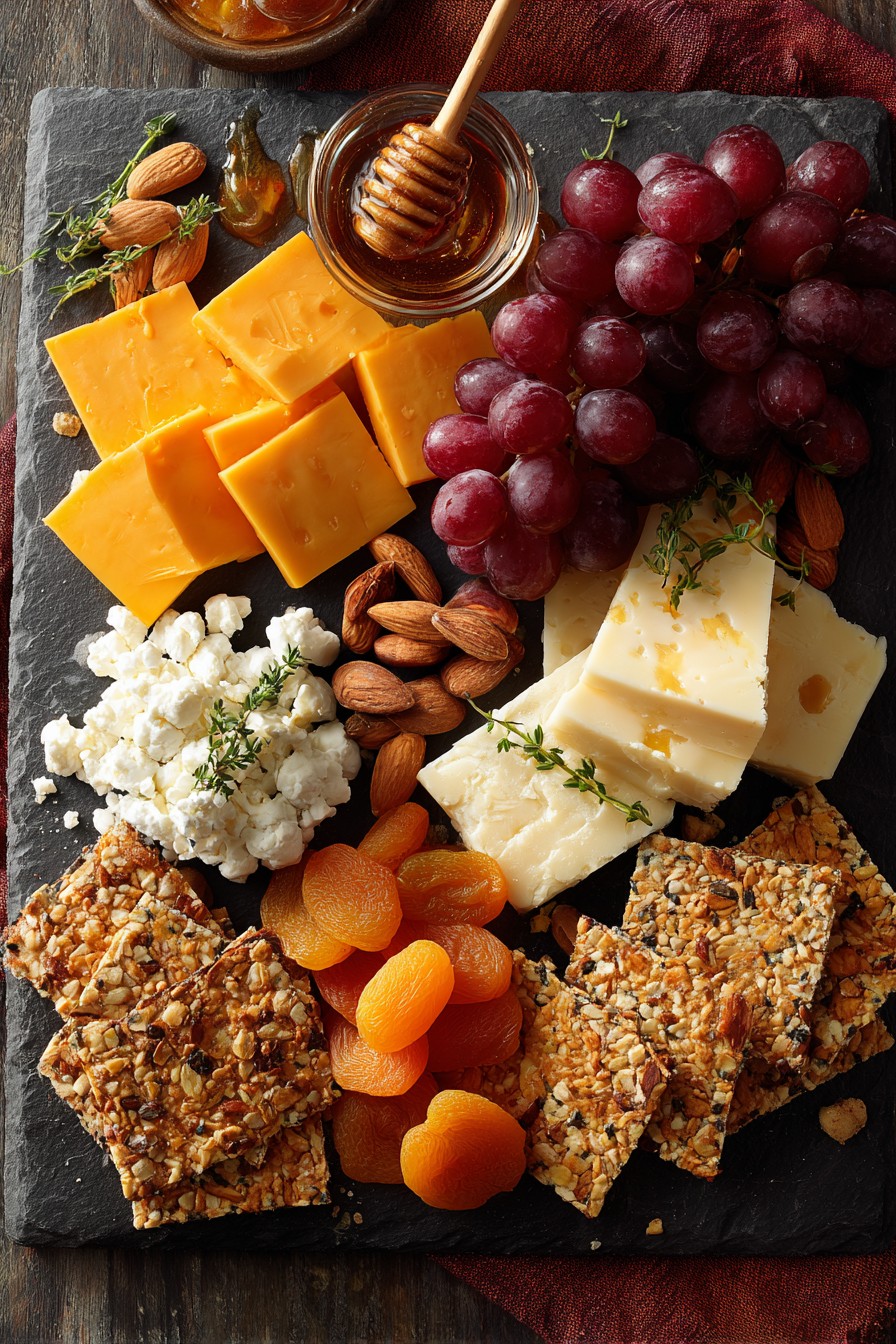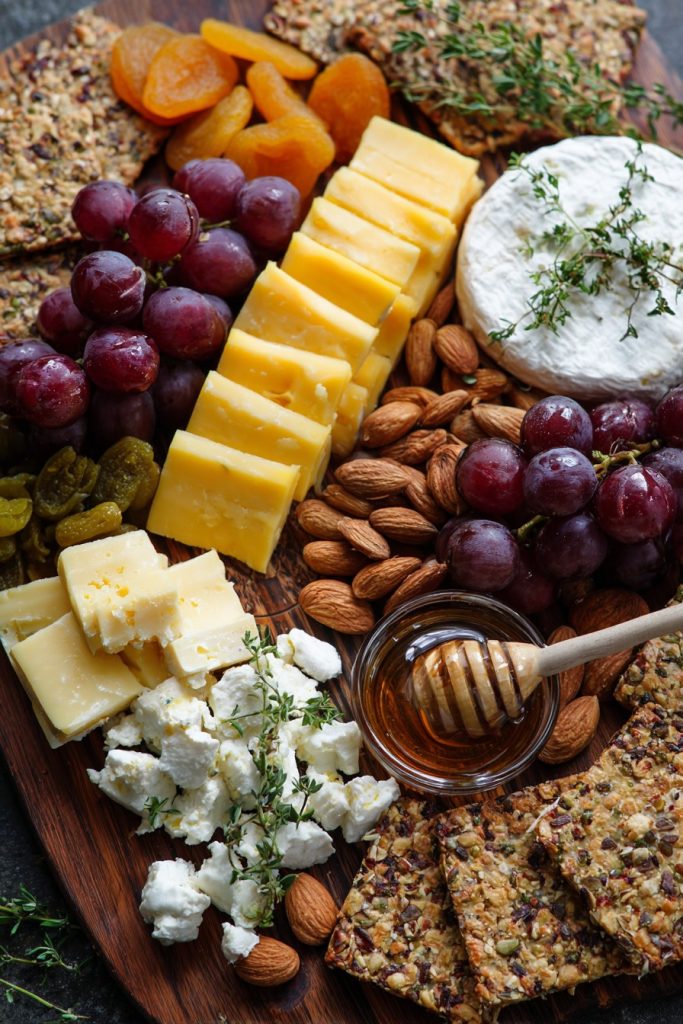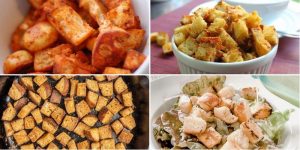Every well-curated cheese board offers more than just delicious flavors—it provides a balanced nutritional experience that combines protein-rich cheeses with antioxidant-packed accompaniments. Elevating your entertaining game while maintaining health-conscious choices has never been simpler than with this thoughtfully designed small cheese board that prioritizes both taste and wellness benefits.
Why This Recipe Works
- Strategic cheese selection combines different milk types and aging processes to provide diverse protein structures and digestive benefits, with goat cheese offering easier digestibility for those sensitive to cow’s milk casein
- Nutritional balance is achieved through the inclusion of complex carbohydrates from whole grain crackers, healthy fats from nuts, and natural sugars from fresh and dried fruits that provide sustained energy release
- Antioxidant-rich accompaniments like grapes and berries deliver essential phytonutrients while the inclusion of fermented elements like cornichons supports gut health through natural probiotics
- Portion control is built into the design, making it ideal for individual servings or small gatherings while preventing overconsumption through thoughtful ingredient distribution
- The combination of textures and flavors stimulates different taste receptors while providing varied chewing experiences that can enhance satiety signals and mindful eating practices
Ingredients
- 4 ounces aged cheddar cheese, cut into 1/4-inch thick slices
- 3 ounces soft goat cheese, crumbled
- 2 ounces gouda cheese, cut into small cubes
- 1 cup red seedless grapes, washed and patted dry
- 1/2 cup whole almonds, raw and unsalted
- 1/4 cup dried apricots, sliced into thin strips
- 1/4 cup cornichons, drained and patted dry
- 8 whole grain crackers, preferably seeded variety
- 2 tablespoons honey, for drizzling
- 1 tablespoon fresh thyme leaves, for garnish
Equipment Needed
- Medium-sized wooden cutting board or serving platter
- Sharp chef’s knife
- Cutting board for prep work
- Small bowls for accompaniments
- Cheese knife or spreader
- Measuring cups and spoons
Instructions

Prepare Your Cheese Selection
Begin by removing all cheeses from refrigeration approximately 30-45 minutes before assembling your board to allow them to reach optimal serving temperature, which enhances both flavor development and texture. The aging process in cheddar cheese creates tyrosine crystals that provide delightful crunch and concentrated umami flavors, while the goat cheese offers beneficial medium-chain fatty acids that are more easily metabolized. Cut the aged cheddar into substantial slices approximately 1/4-inch thick to showcase its crystalline structure, then crumble the goat cheese to create textural variety. Cube the gouda into bite-sized pieces that highlight its smooth, creamy interior. This temperature adjustment period is crucial because cold cheese masks subtle flavor notes and makes the fat molecules less receptive to our taste buds, significantly diminishing the overall tasting experience and nutritional absorption.
Arrange Cheese Components Strategically
Position your cheese varieties in triangular formation across your serving board, leaving adequate space between each type to prevent flavor transfer and allow for easy access. Place the aged cheddar slices in a slightly overlapping pattern near one corner, followed by the crumbled goat cheese in a small mound toward the center, and distribute the gouda cubes in a cluster opposite the cheddar. This strategic placement creates visual appeal while ensuring each cheese maintains its distinct character. The triangular arrangement isn’t just aesthetically pleasing—it encourages guests to move around the board, experiencing different flavor combinations as they progress. This method also supports portion awareness, as the physical separation helps prevent overconsumption of any single cheese type while promoting balanced tasting.
Add Fresh and Dried Fruits
Carefully wash and thoroughly dry your red seedless grapes to remove any pesticide residue or natural bloom, then arrange them in small clusters near the cheese varieties they complement best. The natural fructose in grapes provides quick energy while their high water content helps cleanse the palate between different cheese tastings. Position the sliced dried apricots in a small pile near the goat cheese, as their tangy sweetness beautifully contrasts with the cheese’s earthy notes. Dried fruits concentrate natural sugars and fiber, offering sustained energy release while supporting digestive health. The combination of fresh and dried fruits provides both hydration benefits and concentrated nutrients, creating a balanced approach to fruit inclusion that caters to different taste preferences and nutritional needs throughout the tasting experience.
Incorporate Nuts and Savory Elements
Measure precisely 1/2 cup of raw, unsalted almonds and scatter them strategically across empty spaces on your board, creating bridges between different cheese sections. Almonds provide essential monounsaturated fats, vitamin E, and magnesium while adding satisfying crunch. Their neutral flavor profile makes them versatile pairing partners for all cheese varieties. Arrange the drained cornichons in a small group near the aged cheddar, as their vinegar brine cuts through the cheese’s richness while providing probiotic benefits from the fermentation process. The strategic placement of these savory elements creates balance points that allow guests to reset their palates between different cheese experiences, enhancing their ability to discern subtle flavor differences while adding valuable nutritional components to the overall board composition.
Finalize with Crackers and Garnishes
Artistically position your whole grain crackers around the board’s perimeter, leaning some against cheese mounds and placing others flat to create visual depth and easy accessibility. The complex carbohydrates in seeded crackers provide sustained energy release while their fiber content supports digestive health. Drizzle the honey in delicate streams across the goat cheese and near the dried apricots, using approximately 2 tablespoons total to enhance sweetness without overwhelming other flavors. Honey contains natural antioxidants and enzymes that can aid digestion when paired with dairy. Finally, sprinkle fresh thyme leaves across the board, focusing particularly on the goat cheese and cheddar areas. Thyme not only adds visual appeal but also contains thymol, a compound with antimicrobial properties that can support immune function while complementing the cheese flavors beautifully.
Tips and Tricks
When selecting cheeses for optimal nutritional benefit, consider incorporating varieties from different animal milks to diversify your protein sources and fat profiles. Sheep’s milk cheeses like manchego provide higher concentrations of zinc and B vitamins compared to cow’s milk options, while buffalo milk mozzarella offers a unique protein structure that some find easier to digest. For those monitoring sodium intake, seek out younger cheeses that typically contain less salt than their aged counterparts, and always read nutrition labels carefully since sodium content can vary significantly even within the same cheese category.
Temperature management extends beyond simply bringing cheese to room temperature before serving. During warmer months, consider placing your assembled board in a cool area (approximately 60-65°F) for 10-15 minutes before serving to prevent softer cheeses from becoming too oily or losing their structure. Conversely, in cooler environments, you might need to extend the coming-to-room-temperature period to ensure optimal flavor development. The fat composition in cheese determines how it responds to temperature changes—higher fat cheeses like triple crèmes will soften more dramatically than firm, aged varieties.
Pairing philosophy should consider both complementary and contrasting elements to create a balanced tasting experience. Acidic components like pickled vegetables or citrus segments cut through the richness of high-fat cheeses while supporting digestion. Sweet elements like honey or fruit preserves balance salty cheeses and can help mitigate the intensity of blue cheeses. Textural contrasts between creamy, crunchy, and chewy components not only enhance the eating experience but also promote mindful eating by requiring different chewing patterns that increase satiety signals.
For optimal freshness and food safety, understand that hard, aged cheeses can remain at room temperature for up to four hours, while softer, high-moisture cheeses should not sit out for more than two hours. If you’re serving the board over an extended period, consider bringing out smaller portions of softer cheeses sequentially rather than displaying everything at once. Always use separate utensils for different cheese types to prevent cross-contamination of flavors and bacteria, and provide small plates to encourage proper portioning rather than eating directly from the shared board.
Recipe Variations
- For a Mediterranean-inspired board, substitute the cheddar with feta cheese crumbles, replace almonds with kalamata olives, and add roasted red pepper strips and artichoke hearts. This variation increases the monounsaturated fat content from olives while providing additional antioxidants from peppers. Include whole wheat pita triangles instead of crackers and garnish with fresh oregano. The briny feta offers a different calcium profile while the olives contribute heart-healthy fats that can support cardiovascular function.
- Create a vegan cheese board by using plant-based cheese alternatives made from cashews or almonds, supplemented with marinated tofu cubes for protein. Include roasted chickpeas for crunch instead of traditional nuts, and add plenty of fresh vegetable crudités like carrot sticks, cucumber slices, and radishes. Use tahini drizzled with lemon juice as a honey alternative. This variation provides complete plant-based nutrition while maintaining the social and sensory experience of cheese board entertaining.
- For a lower-carb option, focus on high-protein cheeses like parmesan and aged gouda, include plenty of raw vegetables like bell pepper strips and celery, and use seed crackers or cheese crisps instead of grain-based crackers. Add olives and avocado slices for healthy fats, and include a small portion of berries for natural sweetness without excessive sugars. This approach supports blood sugar management while providing satiating protein and fiber.
- Transform your board into a breakfast or brunch presentation by including hard-boiled eggs quartered lengthwise, adding smoked salmon rolls, and incorporating a small dish of Greek yogurt with honey. Use whole grain toast points instead of crackers and include fresh berries alongside the grapes. This variation increases protein content significantly while providing energy-sustaining nutrition perfect for morning gatherings.
Frequently Asked Questions
How far in advance can I assemble a cheese board?
You can prepare individual components up to 24 hours in advance, but final assembly should occur within 2 hours of serving for optimal food safety and quality. Hard cheeses can be pre-cut and stored wrapped in parchment paper in the refrigerator, while softer cheeses should be cut just before serving to maintain texture. Fruits and vegetables can be washed and dried ahead of time, but cut fruits may oxidize if prepared too early. Nuts can be toasted in advance and stored at room temperature. The key is maintaining proper refrigeration until shortly before serving, then allowing cheeses to come to room temperature for 30-45 minutes. This approach ensures food safety while maximizing flavor development and texture.
What are the best cheese combinations for digestive sensitivity?
For those with lactose sensitivity, focus on aged cheeses like cheddar, gouda, and parmesan that naturally contain minimal lactose due to the aging process. Goat and sheep milk cheeses often prove more digestible for some individuals because their fat molecules are smaller and protein structures differ from cow’s milk. Always include high-fiber elements like whole grain crackers and fresh fruits to support digestion, and consider adding fermented items like pickles that provide natural probiotics. Avoid processed cheese products that may contain additives that can trigger digestive issues, and listen to your body’s responses to different dairy types to identify your personal tolerance levels.
How do I determine appropriate portion sizes?
As a general guideline, plan for 2-3 ounces of total cheese per person when the board is part of a larger meal, or 4-5 ounces if it’s the main focus. For accompaniments, allocate approximately 1/4 cup of nuts, 1/2 cup of fruits, and 4-6 crackers per person. These portions provide balanced nutrition without excessive calories, offering adequate protein from cheeses, healthy fats from nuts, and complex carbohydrates from crackers and fruits. Consider your guests’ dietary needs and the presence of other food items when finalizing quantities. Visual cues can help—the board should appear generously filled but not overcrowded, with clear spaces between different components.
What are the healthiest cracker options for a cheese board?
Seek out whole grain crackers with minimal added sugars and recognizable ingredients. Look for options containing seeds like flax, chia, or sunflower for added fiber and omega-3 fatty acids. Rice crackers offer a gluten-free alternative but typically provide less fiber, so balance them with other high-fiber components on your board. Read nutrition labels carefully—ideal crackers contain at least 3 grams of fiber per serving and minimal added sodium. You can also consider using sliced apples or pear as a cracker alternative for reduced carbohydrates and increased nutrient density. The crackers should complement rather than dominate the cheese flavors while contributing meaningful nutritional value to the overall board.
Summary
This thoughtfully designed small cheese board combines diverse textures and flavors while prioritizing nutritional balance through strategic ingredient selection. The combination of protein-rich cheeses, fiber-packed accompaniments, and healthy fats creates a satisfying tasting experience that supports overall wellness. Proper assembly techniques enhance both visual appeal and functional serving while maintaining food safety standards.
Small Cheese Board
6
servings20
minutesIngredients
Instructions
- 1 Remove cheeses from refrigeration 30-45 minutes before assembling to reach room temperature
- 2 Cut cheddar into slices, crumble goat cheese, and cube gouda
- 3 Arrange cheeses in triangular formation on serving board
- 4 Add grape clusters and dried apricots near complementary cheeses
- 5 Scatter almonds and position cornichons strategically
- 6 Place crackers around perimeter and drizzle honey over goat cheese
- 7 Sprinkle with fresh thyme leaves before serving



